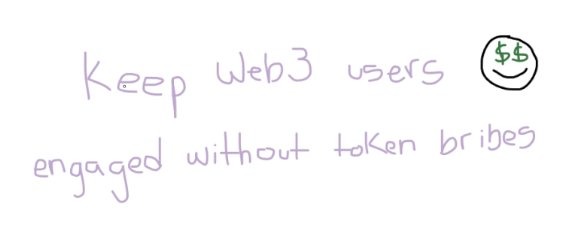How to Keep Web3 Users Engaged Without Token Bribes

Keeping users engaged and loyal in Web3 is one of the biggest challenges any project faces. With the fast-paced nature of the industry, financial incentives creating mercenary behavior, and high competition for attention, most projects struggle to retain users once the hype fades.
In this post, we’ll break down six core strategies to help you reduce churn and build long-term engagement in your Web3 project. These aren’t quick fixes. They’re foundational practices built to create real connection, loyalty, and community ownership.
1. Nail Your Brand Positioning and Narrative
Your brand positioning defines how your project is perceived in the market. It answers questions like: What problem do you solve? For whom? And how do you do it differently?
There are two common approaches:
- Category creation: If your solution is novel, define a new category. This gives you narrative control, as seen with EigenLayer and restaking.
- Differentiation: If you’re in an existing category, focus on unique advantages. Ethereum and Solana both offer smart contracts, but Ethereum emphasizes versatility while Solana positions itself as fast and cheap.
Your positioning must:
- Be based in substance, not hype
- Be simple to understand
- Emotionally resonate with a specific audience
You want users to feel like your product was made for them. That emotional connection leads to stronger attention, retention, and advocacy.
Pro tip: It’s okay to iterate on your messaging. But don’t jump from one buzzword to another. If you’re a DePIN project this week and an AI solution the next, users will lose trust.
It’s also important to test your positioning and messaging early. See what resonates with your audience and refine it as you learn more. A clear narrative that speaks to your ideal users will increase retention by helping them see your product as essential.
2. Curate and Cultivate Your Initial Community
Narrative and positioning attract attention. But what keeps people around is community. And real communities are curated, not manufactured through mass airdrops or questification.
Many Web3 projects mistake high Discord numbers for meaningful traction. But if most members are there for a quick reward, you’ll struggle to build depth.
Here’s how to do it right:
- Focus on cultural, economic and financial alignment
- Start with 20 to 30 users who genuinely use and care about the product
- Build direct relationships and gather feedback
These early evangelists are your first line of organic growth. Their stories and enthusiasm will bring others in.
Avoid relying on token or cash incentives. These short-term tactics breed instability and high churn. If you want sustainable engagement, build trust and community the hard way: through genuine relationships.
Many founders try to fast-track growth through giveaways and referral campaigns. While these may increase surface-level metrics, they rarely translate into meaningful engagement. Instead, focus on smaller groups who are deeply aligned with your mission.

3. Foster Many-to-Many Relationships
It’s easy to build one-on-one relationships between your brand and your users. But real community emerges when users build relationships with each other.
Many-to-many interactions build network effects. People stick around not just for your product, but because of the people they meet and the value they find through those connections.
To encourage this:
- Host events (digital and physical) where people can meet
- Set up channels for peer collaboration and discussion
- Celebrate collaborations and peer contributions
When people get tangible value from others in your community, they attribute that value to your brand. That shared experience strengthens loyalty.
Solana’s ecosystem, for example, thrives in part because of Superteam chapters around the world. These regional hubs bring users together in ways that are personal and empowering.
Facilitate community-generated value. Be the connector, not the hero.
4. Design Thoughtful Events and Experiences
Not all events are equal. Too many projects run generic AMAs and meme contests. These might create noise, but they rarely lead to deep engagement.
Instead, think strategically:
- Who are your users?
- What are their preferences, schedules, and motivations?
- What kind of events would provide real value to them?
Then, create:
- Intimate product workshops
- IRL community meetups and retreats
- Co-branded sessions with integrators
- User-only demo days and networking events
Use these as opportunities to connect directly with core users. Share meals. Shake hands. Understand their needs. Let them feel seen and heard.
People are more likely to stick with a product when they feel part of something bigger than themselves.
Make events personal. Reach out to your most engaged users. Ask them what they’d like to see. Invite them to co-create the experience. When users feel like events are built for them, they’re more likely to participate and stick around.
5. Communicate Openly and Transparently
Transparency is your secret weapon against churn.
Many projects go silent during delays or try to spin challenges as wins. But users see through that. In a space full of scams and broken promises, honesty builds trust.
Here’s how to communicate better:
- Share milestone updates, even if you missed them
- Explain product decisions and pivots
- Be open about challenges and delays
Vulnerability breeds respect. When users feel informed, they’re more likely to give you the benefit of the doubt and stick around during tough times.
Transparency doesn’t mean oversharing. It means treating your community like insiders, not outsiders.
When you’re transparent about your roadmap and goals, your community becomes more forgiving and more involved. This kind of relationship prevents churn, even when things get tough.

6. Activate and Refresh Engagement Regularly
Activation isn’t a one-time campaign. It’s an ongoing cycle.
Build a roadmap of activations that gives your users a steady stream of ways to participate and grow. These can include:
- Seasonal campaigns
- Partner challenges
- Community-created content tracks
- Regional workshops and hackathons
Look at Solana as a case study. Their global hackathons and Breakpoint conference are supported by ongoing efforts from regional Superteams. These local hubs run workshops, builder houses, and other programs that feed into Solana’s broader ecosystem.
This creates a sense of motion. There’s always something happening. No stagnation.
Retention comes from relevance. And relevance comes from momentum.
To maintain user interest over time, constantly refresh your community’s experience. Introduce new collaboration formats, fresh content series, and opportunities for recognition. Make it feel like there's always something to look forward to.
Don’t let your community go cold. Keep giving them reasons to show up, collaborate, and build.
Keeping Users the Right Way
Retention is about continuously giving them compelling reasons to stay. In Web3, that means:
- Defining your position and story clearly
- Building a community with care and intent
- Helping users build meaningful relationships
- Creating thoughtful events and touchpoints
- Communicating with radical transparency
- Rolling out new engagement loops consistently
Retention is a relationship. The more you give, the more people will invest in return.
Looking for help building a Web3 community that stays active and engaged? Check out our free resources or book a call with our team to design your strategy.

